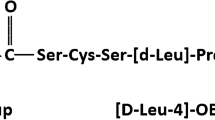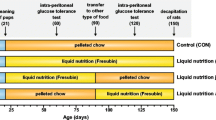Abstract
Young female Zucker fa/fa rats of 370-430 g were implanted with osmotic minipumps releasing 3.5 μmol/dayúkg of estrone oleate in liposomes (Merlin-2) into the bloodstream for up to 14 days. Merlin-2 induced a sustained loss of appetite, and a decrease in body weight of 3.5%, which contrasts with the 8.2% increase in controls during the period studied. Plasma insulin, glucose and urea decreased, and liver glycogen increased with Merlin-2 treatment. Plasma ACTH and corticosterone increased to a maximum at the end of the experiment. The expression of the ob gene in adipose tissue was unchanged, and plasma leptin levels were also unchanged by treatment. Estrone levels increased more than 1500-fold, and estrone oleate rose 100-fold during treatment. The fact that estrone oleate had no effect on the leptin levels or expression in obese rats, in contrast with the marked inhibition observed in the lean suggests that the functionality of the leptin receptor is essential for estrone oleate inhibition of the ob gene. This also suggests that leptin may control ob gene expression in white adipose tissue and that estrone oleate may activate this process. The slimming effect of estrone oleate is, thus, not directly dependent on leptin, since both normoleptinemic and hyperleptinemic animals lose fat following treatment nor are the effects on appetite and energy expenditure mediated by leptin. However, leptin levels and the expression of the ob gene are directly linked with estrone oleate function. A possible involvement of leptin in estrone oleate action is postulated. The results support the participation of estrone oleate in the control of body weight and hint at the complexity of its regulation by leptin and glucocorticoids.
Similar content being viewed by others
References
Iida M, Murakami T, Ishida K, Mizuno A, Kuwajima M, Shima K: Phenotype-linked amino acid alteration in leptin receptor cDNA from Zucker fatty, fa/fa rat. Biochem Biophys Res Commun 222: 19–26, 1996
Phillips MS, Liu QY, Hammond HA, Dugan V, Hey PJ, Caskey CT, Hess JF: Leptin receptor missense mutation in the fatty Zucker rat. Nature Genet 13: 18–19, 1996
Chua SC, Chung WK, Wu-Peng XS, Zhang Y, Liu SM, Tartaglia L, Leibel RL: Phenotypes of mouse diabetes and rat fatty due to mutations in the OB, leptin receptor. Science 271: 994–996, 1996
Considine RV, Sinha MK, Heiman ML, Kriauciunas A, Stephens, TW, Nyce MR, Ohannesian JP, Marco CC, McKee LJ, Bauer TL, Caro JF: Serum immunoreactive leptin concentrations in normal-weight and obese humans. N Eng J Med 334: 292–295, 1996
Argilés JM: The obese Zucker rat - a choice for fat-metabolism 1968–1988 - 20 years of research on the insights of the Zucker mutation. Prog Lipid Res 28: 53–66, 1989
Godbole V, York DA, Bloxman DP: Developmental changes in the fatty, fa/a rat: Evidence for defective thermogenesis preceding the hyperlipogenesis and hyperinsulinaemia. Diabetologia 15: 41–44, 1978
Planche E, Joliff M, De Gasquet P, Leliepvre X: Evidence of a defect in energy expenditure in 7–day-old Zucker rat, fa/fa. Am J Physiol 245: E107–E113, 1983
Esteve M, Rafecas I, Fernández-López JA, Remesar X, Alemany M: Lipid synthesis: A thermogenic mechanism in cold-exposed Zucker fa/fa rats. Comp Biochem Physiol 105A: 369–376, 1993
Kemmer FW, Berger M, Herberg L, Gries FA, Wirdeier A, Becker K: Glucose metabolism in perfused skeletal muscle. Demonstration of insulin resistance in the obese Zucker rat. Biochem J 178: 733–741, 1979
Meylan M, Felber JP, Henny C, Jequier E, Temler E: Metabolic factors in the insulin resistance in human obesity. Metabolism 36: 256–261, 1987
Storlien LH, Burleigh KM, Chisholm DJ, James DE, Kraegen EW: Fat feeding causes widespread in vivo insulin resistance, decreased energy-expenditure, and obesity in rats. Am J Physiol 251: E576–E583, 1986
Bodkin NL, Nicolson M, Ortmeyer HK, Hansen BC: Hyperleptinemia: Relationship to adiposity and insulin resistance in the spontaneously obese rhesus monkey. Horm Metabol Res 28: 674–678, 1996
Roden M, Price TB, Perseghin G, Petersen KF, Rothman DL, Cline GW, Shulman GI: Mechanism of free fatty acid-induced insulin resistance in humans. J Clin Invest 97: 2859–2865, 1996
Sanchis D, Balada F, Grasa MM, Virgili J, Peinado J, Monserrat C, Fernández-López JA, Remesar X, Alemany M: Oleoyl-estrone induces the loss of body fat in rats. Int J Obesity 20: 588–594, 1996
Sanchis D, Adán C, Ardévol A, Grasa MM, Cabot C, Balada F, Vilà R, Estruch J, Puerta M, Fernández-López JA, Remesar X, Alemany M: Short term-treatment with oleoyl-estrone in liposomes, Merlin-2 strongly reduces the expression of the ob gene in young rats. Biochem J 326: 357–360, 1997
Seeley RJ, Van Dijk G, Campfield LA, Smith FJ, Burn P, Nelligan JA, Bell SM, Baskin DG, Woods SC, Schwartz MW: Intraventricular leptin reduces food intake and body weight of lean rats but not obese Zucker rats. Horm Metab Res 28: 664–668, 1996
Rentsch J, Levens N, Chiesi M: Recombinant ob-gene product reduces food intake in fasted mice. Biochem Biophys Res Commun 214: 131–136, 1995
Zakrzewska KE, Cusin I, Sainsbury A, Rohner-Jeanrenaud F, Jeanrenaud B: Glucocorticoids as counterregulatory hormones of leptin - toward an understanding of leptin resistance. Diabetes 46: 717–719, 1997
Fernández-Real JM, Sanchis D, Ricart W, Casamitjana R, Castañer MF, Soler J, Alemany M: Is oleoyl-estrone a ponderostat signal in humans?. Int J Obesity 21(suppl 2), (abstr): S74, 1997
Balada F, Sanchis D, Virgili J, Grasa MM, Monserrat C, Fernández-López JA, Remesar X, Alemany M: Effect of the slimming agent oleoyl-estrone in liposomes on the body weight of rats fed a cafeteria diet. Arch Physiol Biochem 105: 487–495, 1997
Balada F, Sanchis D, Grasa MM, Virgili J, Estruch J, Fernández-López JA, Remesar X, Alemany M: Effect of the slimming agent oleoyl-estrone in liposomes on the body weight of Zucker obese rats. Int J Obesity 21: 789–795, 1997
Mellon-Nussbaum SH, Ponticorvo L, Schatz F, Hochberg RS: Estradiol fatty acid esters. J Biol Chem 257: 5678–5684, 1982
Ardévol A, Cañas X, Remesar X, Alemany M: Cooling rates of tissue samples during freezing with liquid nitrogen. J Biochem Biophys Meth 27: 77–86, 1997
Ardévol A, Virgili J, Sanchis D, Adán C, Fernández-Real JM, Fernández-López JA, Remesar X, Alemany M: A method for the measurement of plasma estrone fatty-ester levels. Anal Biochem 249: 247–250, 1997
Heding LG: Determination of total serum insulin, IRI in insulin treated diabetic patients. Diabetologia 8: 260–266, 1972
Trinder P: Determination of glucose in blood using glucose oxidase with an alternative oxygen acceptor. Ann Clin Biochem 6: 24–27, 1969
Good CA, Kramer H, Somogyi M: The purification of glycogen. J Biol Chem 100: 485–491, 1933
Serafini MT, Alemany M: A micromethod for the enzymatic estimation of the degree of ramification of glycogen. J Biochem Biophys Meth 15: 33–39, 1987
Folch J, Lees M, Sloane-Stanley GH: A simple method for the isolation and purification of total lipids from animal tissues. J Biol Chem 232: 497–509, 1957
Trayhurn P, Thomas MEA, Duncan JD, Rayner VD: Effect of fasting and refeeding on ob gene expression in white adipose tissue of lean and obese, ob/ob mice. FEBS Lett 368: 488–490, 1995
Sanchis D, Balada F, Picó C, Grasa MM, Virgili J, Farrerons C, Palou A, Fernández-López JA, Remesar X, Alemany M: Rats receiving the slimming agent oleoyl-estrone in liposomes, Merlin-2 decrease food intake but maintain thermogenesis. Arch Physiol Biochem 105: 603–672, 1997
Slieker LJ, Sloop KW, Surface PL, Kriauciunas A, LaQuier F, Manetta J, Bue-Valleskey J, Stephens TW: Regulation of expression of ob mRNA and protein by glucocorticoids and cAMP. J Biol Chem 271: 5301–5304, 1996
De Vos P, Saladin R, Auwerx J, Staels B: Induction of ob gene expression by corticosteroids is accompanied by body weight loss and reduced food intake. J Biol Chem 270: 15958–15961, 1995
Zhang Y, Proenca R, Maffei M, Barone M, Leopold L, Friedman JM: Positional cloning of the mouse obese gene and its human homologue. Nature 372: 425–431, 1994
Björntorp P: Endocrine abnormalities of obesity. Metabolism 44(suppl 3): 21–23, 1995
Balada F: Efecto del oleato de estrona en la obesidad. PhD Thesis, University of Barcelona, 1997
Balada F, Sanchis D, Grasa MM, Virgili J, Estruch J, Fernández-López JA, Remesar X, Alemany M: Differential short-term distribution of estrone and oleoyl-estrone administered in liposomes to lean and obese Zucker rats. Obes Res 6: 34–39, 1998
Zumoff B, Strain GW, Kream J, O'Connor J, Levin J, Fukushima DK: Obese young have elevated plasma estrogen levels but obese premenopausal women do not. Metabolism 30: 1011–1014, 1981
Adlercreutz H, Gorbach SL, Goldin BR, Woods MN, Dwyer JT, Hämäläinen E: Estrogen metabolism and excretion in oriental and caucasian women. J Nat Cancer Inst 86: 1076–1082, 1994
Adán C, Vilà R, Grasa MM, Esteve M, Cabot C, Rafecas I, Estruch J, Remesar X, Alemany M, Fernández-López JA: Oleoyl-estrone treatment improves the Zucker fa/fa rat resistance to insulin. Int J Obesity 21(suppl 2),(abstr): S111, 1997
Collins S, Kuhn CM, Petro AE, Swick AG, Chrunyk BA, Surwit RS: Role of leptin in fat regulation. Nature 380: 677, 1996
Hwa JJ, Ghibaudi L, Compton D, Fawzi AB, Strader CD: lntra-cerebroventricular injection of leptin increases thermogenesis and mobilizes fat metabolism in ob/ob mice. Horm Metab Res 28: 659–663, 1996
Erickson JC, Clegg KE, Palmiter RD: Sensitivity to leptin and susceptibility to seizures of mice lacking neuropeptide Y. Nature 381: 415–418, 1996
Rentsch J, Chiesi M: Regulation of ob gene mRNA levels in cultured adipocytes. FEBS Lett. 379: 55–59, 1996
Mantzoros CS, Qu DQ, Frederich RC, Susulic VS, Lowell BB, Maratos-Flier E, Flier JS: Activation of β3 adrenergic receptors suppresses leptin expression and mediates a leptin-independent inhibition of food intake in mice. Diabetes 45: 909–914, 1996
Alemany M: The etiologic basis for the classification of obesity. Prog Food Nutr Sci 13: 45–66, 1989
Author information
Authors and Affiliations
Rights and permissions
About this article
Cite this article
Adán, C., Grasa, M., Cabot, C. et al. Short-term treatment with estrone oleate in liposomes (Merlin-2) does not affect the expression of the ob gene in Zucker obese rats. Mol Cell Biochem 197, 109–115 (1999). https://doi.org/10.1023/A:1006987115532
Issue Date:
DOI: https://doi.org/10.1023/A:1006987115532




